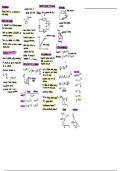Georgegennuso
On this page, you find all documents, package deals, and flashcards offered by seller georgegennuso.
- 10
- 0
- 1
Community
- Followers
- Following
12 items

Capacitance
Capacitance is the ability of a system to store electrical charge when a voltage is applied. It’s measured in farads (F), which indicate how much charge can be stored per volt of potential difference. A capacitor is a device designed to store electrical energy, consisting of two metal plates separated by an insulating material called a dielectric. Capacitors are widely used in electronic circuits for energy storage, filtering, and signal processing. The energy stored in a capacitor is held in ...
- Package deal
- Summary
- • 1 pages •
Capacitance is the ability of a system to store electrical charge when a voltage is applied. It’s measured in farads (F), which indicate how much charge can be stored per volt of potential difference. A capacitor is a device designed to store electrical energy, consisting of two metal plates separated by an insulating material called a dielectric. Capacitors are widely used in electronic circuits for energy storage, filtering, and signal processing. The energy stored in a capacitor is held in ...

Telescopes
In AQA A-Level Physics, telescopes are covered under the Astrophysics unit, focusing on refracting and reflecting telescopes. Refracting telescopes use lenses to collect and focus light but suffer from chromatic aberration and lens size limitations. Reflecting telescopes use mirrors, avoiding chromatic aberration and allowing larger apertures. Key concepts include focal length, magnification, resolving power, and diffraction limits. Radio telescopes also feature, gathering radio waves rather tha...
- Summary
- • 6 pages •
In AQA A-Level Physics, telescopes are covered under the Astrophysics unit, focusing on refracting and reflecting telescopes. Refracting telescopes use lenses to collect and focus light but suffer from chromatic aberration and lens size limitations. Reflecting telescopes use mirrors, avoiding chromatic aberration and allowing larger apertures. Key concepts include focal length, magnification, resolving power, and diffraction limits. Radio telescopes also feature, gathering radio waves rather tha...
